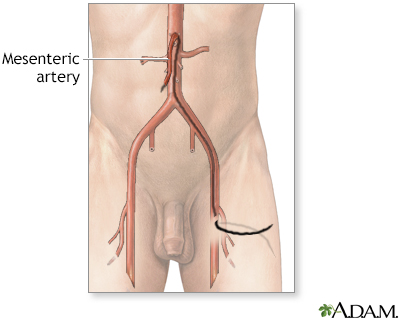Pregnancy SmartSiteTM
Abdominal arteriogram; Arteriogram - abdomen; Mesenteric angiogram DefinitionMesenteric angiography is a test used to look at the blood vessels that supply the small and large intestines. Angiography is an imaging test that uses x-rays and a special dye to see the insides of the arteries. Arteries are blood vessels that carry blood away from the heart. How the Test is PerformedThis test is done in a hospital. You will lie on an x-ray table. You may ask for medicine to help you relax (sedative) if you need it.
Certain treatments can be done during this procedure. These items are passed through the catheter to the area in the artery that needs treatment. These include:
After the x-rays or treatments are finished, the catheter is removed. Pressure is applied to the puncture site for 20 to 45 minutes to stop the bleeding. After that time the area is checked and a tight bandage is applied. The leg where the needle was placed is most often kept straight for another 6 hours after the procedure. You should avoid strenuous activity, such as heavy lifting, for 24 to 48 hours. How to Prepare for the TestYou should not eat or drink anything for 6 to 8 hours before the test. You will be asked to wear a hospital gown and sign a consent form for the procedure. Remove jewelry from the area being imaged. Tell your provider:
How the Test will FeelYou may feel a brief sting when the numbing medicine is given. You will feel a brief sharp pain and some pressure as the catheter is placed and moved into the artery. In most cases, you will feel only a sensation of pressure in the groin area. As the dye is injected, you will feel a warm, flushing sensation. You may have tenderness and bruising at the site of the catheter insertion after the test. Why the Test is PerformedThis test is done:
A mesenteric angiogram may be performed after more sensitive nuclear medicine scans have identified active bleeding. The radiologist can then pinpoint and treat the source. Normal ResultsResults are normal if the examined arteries are normal in appearance. What Abnormal Results MeanA common abnormal finding is narrowing and hardening of the arteries that supply the large and small intestine. This can cause mesenteric ischemia in which the intestine does not receive enough blood to function normally. The problem occurs when fatty material (plaque) builds up on the walls of your arteries. Abnormal results may also be due to bleeding in the small and large intestine. This may be caused by:
Other abnormal results may be due to: RisksThere is some risk of the catheter damaging the artery or knocking loose a piece of the artery wall. This can reduce or block blood flow and lead to tissue death. This is a rare complication. Other risks include:
ConsiderationsTo make a diagnosis, your doctor may also perform a computed tomography (CT) angiography or magnetic resonance angiography (MRA) before or in place of catheter angiography. ReferencesMcquinn CW, Orion KC. Endovascular diagnostic technique. In: Sidawy AN, Perler BA, eds. Rutherford's Vascular Surgery and Endovascular Therapy. 10th ed. Philadelphia, PA: Elsevier; 2023:chap 62. Lo RC, Schermerhorn ML. Mesenteric arterial disease: epidemiology, pathophysiology, and clinical evaluation. In: Sidawy AN, Perler BA, eds. Rutherford's Vascular Surgery and Endovascular Therapy. 10th ed. Philadelphia, PA: Elsevier; 2023:chap 62. van den Bosch H, Westenberg JJM, de Roos A. Cardiovascular magnetic resonance angiography: carotids, aorta, and peripheral vessels. In: Manning WJ, Pennell DJ, eds. Cardiovascular Magnetic Resonance. 3rd ed. Philadelphia, PA: Elsevier; 2019:chap 44. | |
| |
Review Date: 10/18/2022 Reviewed By: Deepak Sudheendra, MD, MHCI, RPVI, FSIR, Founder and CEO, 360 Vascular Institute, with an expertise in Vascular Interventional Radiology & Surgical Critical Care, Columbus, OH. Review provided by VeriMed Healthcare Network. Also reviewed by David C. Dugdale, MD, Medical Director, Brenda Conaway, Editorial Director, and the A.D.A.M. Editorial team. The information provided herein should not be used during any medical emergency or for the diagnosis or treatment of any medical condition. A licensed medical professional should be consulted for diagnosis and treatment of any and all medical conditions. Links to other sites are provided for information only -- they do not constitute endorsements of those other sites. No warranty of any kind, either expressed or implied, is made as to the accuracy, reliability, timeliness, or correctness of any translations made by a third-party service of the information provided herein into any other language. © 1997- A.D.A.M., a business unit of Ebix, Inc. Any duplication or distribution of the information contained herein is strictly prohibited. | |

 Mesenteric arterio...
Mesenteric arterio...
